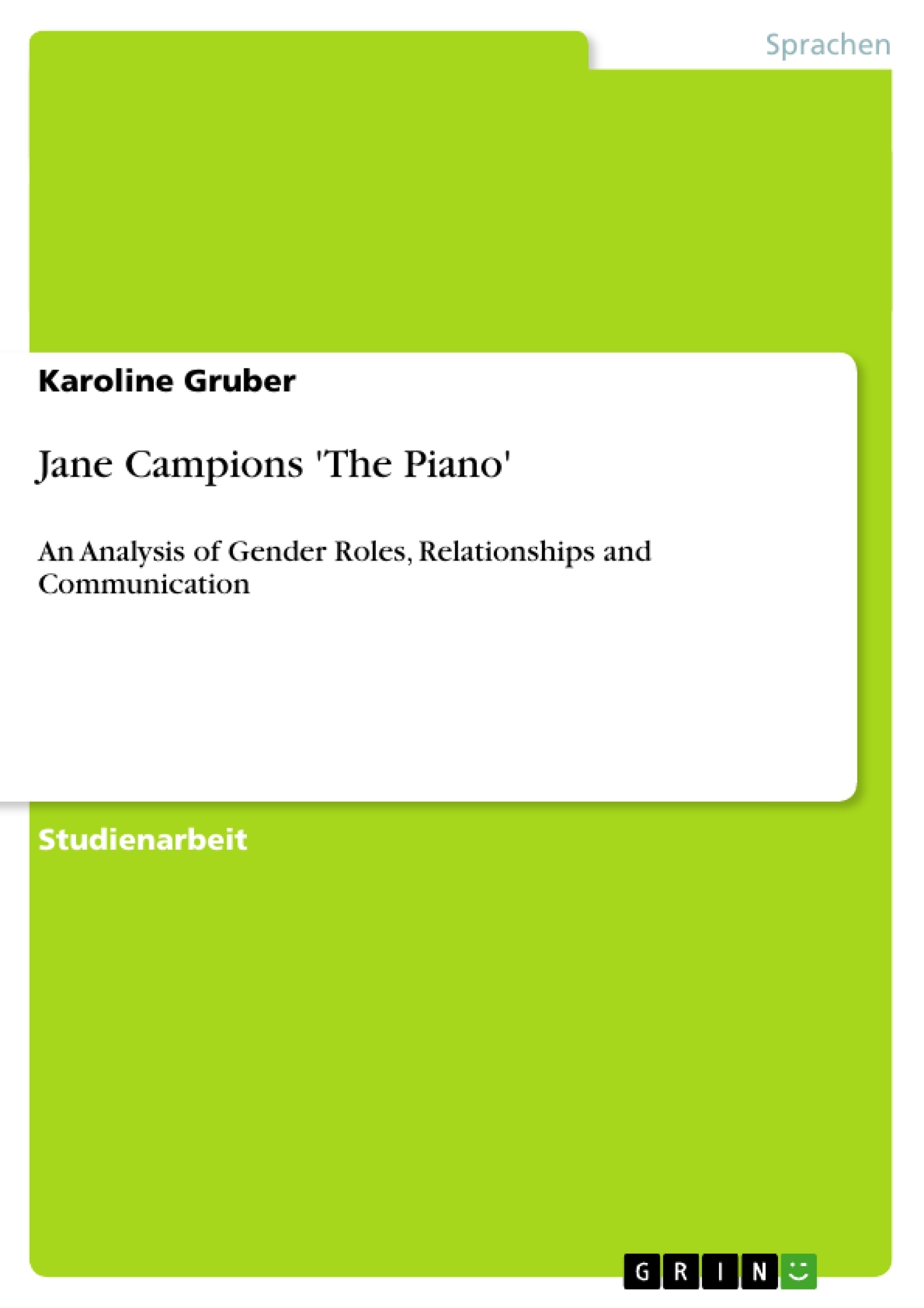Watching Jane Campion’s The Piano, the spectator is taken on an anthropological excursion to New Zealand in the middle of the 19th century. So the movie is set in a Victorian temporal context, and we become witnesses of the arrival of the first European settlers, mostly from England and Scotland. Ada, the protagonist, is an obviously disturbed woman since she has stopped talking at the age of six and even she herself doesn’t know why. The spectator sees him- or herself fascinated about Ada’s mysterious and unusual character as much as about her extraordinarily strong will. Without her consent, she has been married to Stewart, a colonizer living in New Zealand, and now she has to leave Scotland and travel to the unknown country. The movie begins when she and her daughter Flora arrive at New Zealand’s shore.
The Piano features a fair amount of aspects worth to be analyzed. What appears to be the movie’s central role and all-determining, however, is the presentation of gender roles and the wide range of issues that are related to it. Therefore, this paper is going to draw attention to how The Piano demonstrates its characters’ gender identity, sexuality and ways of communicating. For this purpose, it will be important to analyze how the movie reflects the 19th century definition of gender and sexuality and how it has been influenced by the invention of the art of photography, which has often been discussed in psychoanalytic theory. This view on gender roles self-evidently has a substantial effect on Ada’s relationships towards her daughter Flora and towards Stewart and Baines, the men who are both courting her, which will also be examined. What is equally significant for the understanding of sexual identity during that time, however, is the comparison of the European settlers with the Maori people. Throughout the movie, the Maoris serve as a striking antithesis to the colonizers and hence highlight the Europeans’ specific attitudes and behavior. Still, it is not acceptable to simply tolerate the presentation of the Maoris, but it will be an essential part of the paper to profoundly criticize the one-sided view on them.
Inhaltsverzeichnis
- Introduction
- The Movie's Presentation of Gender Ideology and Sexuality
- Ada A Victorian Woman in A Male Dominated World
- Ada and her Relationships to the Other Characters
- Ada and Flora - A Symbiosis
- Ada and Stewart
- Ada and Baines
- The Maoris
- The roles of Maori and Victorian women
- Presentation of the Maoris in The Piano.
- Critique on the Presentation of the Maoris
- The Ending of The Piano.
- Conclusion
- Bibliography
Zielsetzung und Themenschwerpunkte
Die vorliegende Arbeit analysiert Jane Campions Film "The Piano" im Hinblick auf die Darstellung von Geschlechterrollen, Beziehungen und Kommunikation. Der Fokus liegt auf der Präsentation der Geschlechterideologie und Sexualität im viktorianischen Kontext des 19. Jahrhunderts, wobei die Rolle der Fotografie und psychoanalytische Theorien zur Erklärung der Geschlechteridentität herangezogen werden. Die Arbeit untersucht auch die Beziehungen zwischen Ada, der Protagonistin, und anderen Figuren, insbesondere ihrer Tochter Flora, ihrem Ehemann Stewart und dem Verlobten Baines. Darüber hinaus wird die Darstellung der Maori-Kultur im Film analysiert und kritisch betrachtet.
- Darstellung von Geschlechterrollen und Sexualität im viktorianischen Kontext
- Einfluss der Fotografie auf die Geschlechteridentität
- Beziehungen zwischen Ada und anderen Figuren
- Darstellung der Maori-Kultur im Film
- Kritik an der einseitigen Darstellung der Maori
Zusammenfassung der Kapitel
Die Einleitung führt in die Thematik des Films "The Piano" ein und stellt die Hauptthemen der Arbeit vor. Sie beschreibt die Protagonistin Ada als eine ungewöhnliche und faszinierende Frau, die in eine ungewohnte Welt in Neuseeland gebracht wird. Der Film beleuchtet die Geschlechterrollen und die damit verbundenen Probleme im viktorianischen Kontext.
Das zweite Kapitel analysiert die Darstellung der Geschlechterideologie und Sexualität im Film. Es wird die Rolle der Fotografie im 19. Jahrhundert und deren Einfluss auf die Definition von Geschlechteridentität und Sexualität untersucht. Die Arbeit bezieht sich auf psychoanalytische Theorien, insbesondere auf die Konzepte der Scopophilie und des "technischen Blicks".
Das dritte Kapitel konzentriert sich auf Ada als viktorianische Frau in einer von Männern dominierten Welt. Es analysiert ihre Kleidung, die sowohl ihre Sexualität als auch ihre viktorianische Prüderie widerspiegelt. Die Arbeit untersucht auch Adas stumme Natur und ihre mögliche Bedeutung als Widerstand gegen die männliche Dominanz.
Das vierte Kapitel befasst sich mit Adas Beziehungen zu anderen Figuren. Es analysiert die Beziehung zwischen Ada und ihrer Tochter Flora, die eine symbiotische Beziehung zueinander haben. Die Arbeit untersucht auch Adas Beziehung zu Stewart, ihrem Ehemann, und zu Baines, der sich um sie bemüht.
Das fünfte Kapitel analysiert die Darstellung der Maori-Kultur im Film. Es untersucht die Rolle der Maori-Frauen im Vergleich zu den viktorianischen Frauen und die Präsentation der Maori im Film. Die Arbeit kritisiert die einseitige Darstellung der Maori und ihre Rolle als Gegenpol zu den europäischen Kolonialisten.
Schlüsselwörter
Die Schlüsselwörter und Schwerpunktthemen des Textes umfassen Geschlechterrollen, Sexualität, viktorianische Gesellschaft, Fotografie, psychoanalytische Theorie, Scopophilie, "technischer Blick", Ada, Flora, Stewart, Baines, Maori, Kolonialismus, Kritik.
- Quote paper
- Karoline Gruber (Author), 2005, Jane Campions 'The Piano', Munich, GRIN Verlag, https://www.grin.com/document/129648



